Abstract
Open burning of biomass has occurred around the world, and emissions from biomass burning are impacting local, regional, and global air quality issues and climate change. This study focuses on severe biomass burning aerosols (BBAs) in Sumatra in September 2019. The chemical transport simulation model employed in this study is based on a meteorological field simulated by SCALE (Scalable Computing for Advanced Library and the Environmental Regional Model) for offline calculations. Simulation results are validated by using ground-based measurements and biomass burning aerosol distribution observed by JAXA/GCOM-C (Global Change Observation Mission-Climate)/SGLI (second-generation global imager). The results of this study show that the injection process in the model simulations has a significant impact on the aerosol distribution. Aerosols generated by fires can rise to higher altitudes due to the heat of the fire, but aerosols originating from surface and soil fires were found to reproduce well at less elevated injection height.
1. Introduction
Forest fires are emerging as an important environmental problem worldwide. Forest fires are a serious problem in Indonesia in Southeast Asia, where fires tend to occur in forests and peatlands during the dry season when rainfall is low. Every year in Indonesia, fires begin to break out in forests and peatlands with the onset of the dry season, when there is little rainfall. The dry season usually begins around March and ends after about six months, but the number of fires increases particularly sharply from September to October, when the dry season is at its end. Peat is a deposit of dead vegetation that has not decomposed in swamps and other water bodies. Peatlands cover 3% of the Earth’s land area [1]. Peatlands are also widespread in Indonesia, with about half of Indonesia’s peatlands covered by forest [2]. Peat thickness in Indonesia (Sumatra, Kalimantan, and Papua) ranges from less than one m to more than 10 m, but 40% of the peatland area in Indonesia stores thick peat deposits with a peat thickness of more than 2 m [3,4]. The rapid development of peat swamp forests is believed to be responsible for the dramatic increase in Indonesia’s CO2 emissions [2]. On a global scale, CO2 emissions from peatland in Southeast Asia are equivalent to 1.3–3.1% of current global CO2 emissions from fossil fuel combustion [5]. Peatland burning is a major source of greenhouse gas emissions into the atmosphere, as well as a major source of particulate matter, and has an impact on air quality issues.
Associated with a moderate El Niño-like global climate situation, less rain fell in Indonesia in months around September 2019, causing rather serious forest fires probably due to man-made causes [6]. A sharp increase in the number of fires in eastern Sumatra in September 2019 worsened air pollution caused by haze, which had a significant impact on the lives of residents. This large amount of haze caused serious health problems not only in near urban areas, but also in cross-border countries such as Singapore, and caused major social problems, including the temporary closure of schools and public institutions [7].
When forest fires occur, the high heat generated by the energy released by the burning of biomass and the updrafts from convection interact with the surrounding atmosphere to transport haze [8]. Thus, the injection altitude of gases and aerosols emitted from forest fires can be high, sometimes even in the lower stratosphere [9]. Using data from the Multi-Angle Imaging Spectroradiometer (MISR) on board the Terra satellite, an initial assessment of smoke emanating from the Alaska–Yukon region in the summer of 2004 reported that at least about 10% of the wildfire smoke had reached the free troposphere [10]. Fires originating from vegetation in agricultural and prairie areas are not as intense as those originating from boreal forests, but they can produce plumes that reach the free troposphere. Fires originating from vegetation in agricultural and prairie areas, which are not as intense as fires originating from boreal forests, can also produce plumes above the atmospheric boundary layer [11]. The way a fire emits into the atmosphere is highly variable and susceptible to smoke plume dynamics. In addition to the use of satellite observations [12], extensive impacts of emissions from forest fires are being investigated using atmospheric chemical transport models [13,14]. Such models require information on the amount and timing of emissions from fires, which are typically obtained from emission inventories [15,16,17,18]. In order for models to accurately represent forest fire conditions, information about the altitude at which fire-generated chemical species are released into the surrounding atmosphere is also needed. However, the chemical transport model with a horizontal resolution of several kilometers and a vertical resolution of several hundred meters cannot resolve the plume dynamics on the scale of a few meters [19]; parameterizations are therefore required to represent these plume injection heights. These injection heights are key inputs for chemical transport modeling, as they are critical for determining the distance and direction the smoke will travel [10].
The following is an overview of the various injection height parameterizations used in the chemical transport model. Because of the complexity of fire plume dynamics, chemical transport models often assume that all pollutants are contained only within the boundary layer and assume a single fixed elevation for all biomass combustion emissions [20]. Several studies have developed parameterizations of the plume rise model [21,22,23]. Detailed fire-by-fire validation of the parameterization of plume rise has not been carried out, but it has been introduced into several models [24,25]. These studies indicate that the evaluation of plume uplift effects in large-scale atmospheric transport simulations is a challenging task [26]. Alternatives to the unreliable predictions of the plume rise model have been reported, including a statistics-based approach using plume height measurements from the MISR data set [14,27]. However, such a method is probably affected by MISR observation bias. Thus, issues remain regarding the treatment of the injection height of forest fire origin aerosols in chemical transport models.
This study focuses on the fires that occurred in eastern Sumatra in September 2019 and uses chemical transport modeling to investigate how the air pollutants generated by the fires were dispersed. In particular, we investigate how the diffusion is affected by differences in the injection height of the fire origin aerosol plume. Furthermore, simulation results will be compared and validated using aerosol abundances measured by ground and satellite observations. This study is the result of a limited area and limited location for forest fires in Sumatra. However, the results obtained contribute to the understanding of aerosol emission processes from forest fires, using the chemical transport model as a case study.
2. Methods
2.1. Target Area
In 2019, from July to October in Sumatra and Kali Mantan islands, large-scale forest fires occurred, and smoke damage was a serious situation. A large number of hotspots, high temperatures as determined by the National Aeronautics and Space Administration (NASA)/Terra/MODIS/MOD14 satellite imagery, occurred in Sumatra Island in this period. The number of hotspots increased dramatically, especially from early to late September. The area of interest for this study is the island of Sumatra, Indonesia. Indonesia is formed by numerous islands. The right-hand side of Figure 1 shows Java, Kalimantan, and Sumatra, but the target area of this study is the part of Sumatra shown in the left-hand side of Figure 1. The black square on the map in Figure 1 indicates a NASA aerosol robotic network (AERONET) site, Jambi (1.632°S, 103.642°E). There were days in September 2019 when the aerosol optical thickness at 500nm exceeded 5 at this site, but the target date was 21 September, when the optical thickness was particularly large.

Figure 1.
Topographic map around Sumatra Island, Indonesia.
2.2. Model Simulation
A chemical transport model [28,29] was implemented and used the Scalable Computing for Advanced Library and Environment (SCALE) meteorological model [30,31] results for offline calculations. Figure 2 illustrates the model framework. A mesoscale analysis produced by the final global tropospheric analyses produced by NCEP’s Global Forecast System was used for the initial and boundary conditions of the SCALE. The chemical transport model consists of advection, turbulent diffusion, gas-phase photochemistry, secondary organic aerosol chemistry, liquid-phase chemistry, heterogeneous chemical reactions, and aerosol microphysical processes. The period covered was 21 September 2019. Figure 1 shows the simulation domain, which covers Sumatra Island with a grid resolution of 5 km latitude and 5 km longitude. The number of the vertical grid cells is 19 (reaching up to 10,000 m), with terrain following the same coordinates.

Figure 2.
Framework of model system.
The September 2019 wind field in Sumatra Island, the subject of this study, was examined against objective analytical data. Figure 3a is a wind velocity vector at 850 hPa from NCEP-FNL, and southeasterly winds are dominant over Sumatra Island. On the other hand, southerly winds are seen blowing over the sea northeast of Sumatra Island. Figure 3b shows the wind velocity vector at 850 hPa simulated by SCALE, which also shows southeasterly winds over Sumatra Island and southerly winds in the upper right region of the figure. This confirms that the wind field in SCALE is reproduced without any inconsistency.
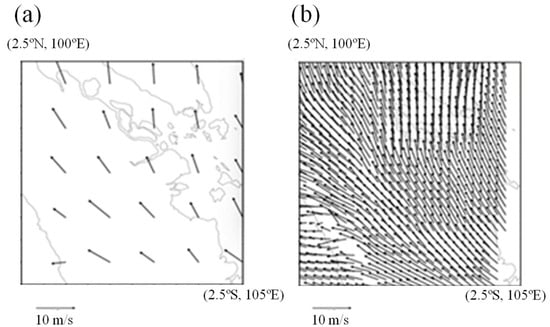
Figure 3.
Wind velocity vector at 850 hPa at 0:00 UT on 21 in September 2019. (a) NCEP-FNL and (b) SCALE.
The amount of air pollutants generated by biomass combustion is estimated from the amount of combustion per unit area, combustion area, combustion efficiency, and emission factors. Since fires are hot at the source, information on the detection of high-temperature anomalies from satellite observations can be used to obtain this information. We used the Global Fire Assimilation System [18] for biomass burning emissions. The Global Fire Assimilation System assimilates NASA’s Terra MODIS and Aqua MODIS fire products and provides emissions from daily biomass burning.
Biomass burning is a major contributor of aerosols to the atmosphere. Because the fire releases a significant amount of heat, the resulting plume has buoyancy that generates a strong updraft. This causes the plume to rise to a considerable height in the atmosphere, but as it mixes with the surrounding air, the plume’s temperature and buoyancy decrease. Eventually, the plume reaches a stable layer where the updraft stops [32]. It was reported that convection may carry biomass burning emission plumes above the planetary boundary layer and sometimes above the tropopause [33]. This complicates the vertical structure of smoke from a biomass burning. The vertical information of biomass burning plume is a major parameter for a proper understanding and modeling of the atmospheric chemistry. Changes in the injection height may extend or shorten the lifetimes of trace chemical species and alter the spatial extent of atmospheric smoke impacts [14].
To investigate the sensitivity of the aerosol distribution of biomass burning origin to the injection height, two different simulations with different injection heights were performed. In this simulation, the model is given the injection height, which is the height at which the emissions are injected in the model. Because the rising mechanism of forest fires also depends on fire temperature and burn area, which are difficult to assess in models, aerosol emissions from forest fires in the aerosol chemical transport model [34] are given at heights up to 3 km with a constant mixing ratio, with reference to observations [35,36]. In other models, aerosols emitted by biomass combustion are uniformly injected into the boundary layer [37], or biomass combustion emissions are uniformly distributed from the bottom layer up to 1 km [28]. With reference to these, the injection height of biomass burning origin aerosols was set to 3 km for Scenario 1 (S1) and 1 km for Scenario 2 (S2).
2.3. Observations
The simulated aerosol distribution of biomass burning origin was validated using ground measurements and satellite data. The NASA/AERONET data were used as ground measurements to validate the model simulation. AERONET has provided the accurate AOT values with Cimel sun–sky radiometer [38]. We used Level 2.0 data of version three of the AERONET database [39]. In addition, data on near-ground PM2.5 concentrations observed were used to validate the simulation results.
The Japanese mission JAXA/GCOM-C launched in 2017 carried SGLI. The SGLI contains 19 channels from near-UV to thermal infrared (IR), including red (674 nm named PL1 band) and near-IR (869 nm; PL2 band) polarization channels. We engaged in the characterization of biomass burning aerosols integrating SGLI data features and the regional model [40,41,42]. Using satellite data and simulations, the horizontal and vertical distribution of aerosols originating from forest fires was discussed.
3. Results
3.1. Comparison of Simulations with Different Injection Heights
This section compares and discusses the simulation results for different injection heights. Figure 4 shows the simulation of case S1 with biomass burning origin aerosol emissions up to an altitude of 3 km, and Figure 5 shows the case S2 with an injection altitude of 1 km. Figure 4a presents the simulated black carbon (BC) distribution by altitude. It can be seen that the BC concentration in the lower layer is higher in S2 than that in S1. This is because emissions are distributed in layers up to 3 km in S1 and up to 1 km in S2, without changing the emission fluxes in all layers in S1 and S2.
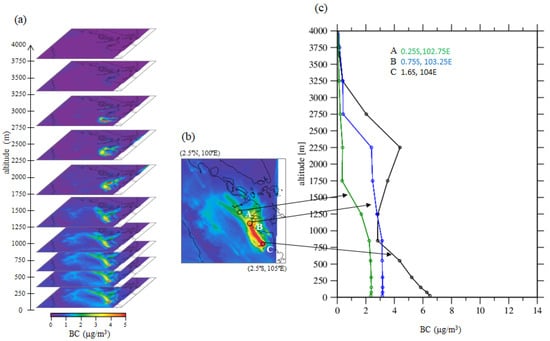
Figure 4.
BC concentration distribution by regional chemical transport model at 3:30 UT on 21 September 2019 for S1. (a) shows distribution by altitude, (b) shows distribution of vertical accumulation, and (c) shows vertical distribution of points circled in black in (b).
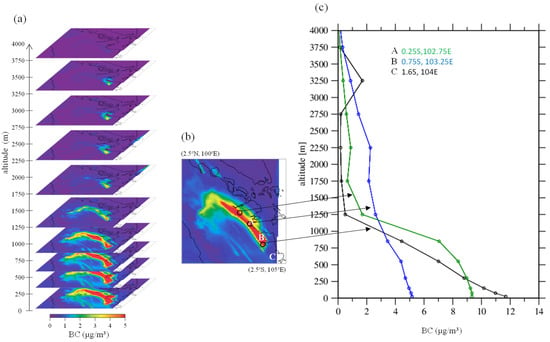
Figure 5.
Same as Figure 4 but for S2. (a) shows distribution by altitude, (b) shows distribution of vertical accumulation, and (c) shows vertical distribution of points circled in black in (b).
Figure 4b and Figure 5b show the distribution of vertical accumulation of BC. In both simulations, BC are distributed in the northwest direction. However, there is a difference between the simulation results of S1 and S2, as S1 shows that the BC distribution extends in the northern direction. Compared to S1, where the injection altitude is 3 km, S2, where the injection altitude is 1 km, shows a higher concentration of BC spreading in the northwest direction and a lower concentration of BC spreading in the north direction. The wind direction is predominantly northwesterly near the surface and northerly at upper altitudes, which is thought to be the reason for the difference in distribution.
Next, the vertical distributions of BC concentrations at S1 and S2 at the three sites indicated by black circles in Figure 4b and Figure 5b shown in Figure 4c and Figure 5c are compared. The distribution also shows that S2 has a high BC concentration in the lower layers, while S1 has a low BC concentration in the lower layers, but the same level of BC as in the lower layers is distributed up to an altitude of about 3 km. Comparing the concentration at the most easterly point A between S1 and S2, the concentration at S1 is lower, indicating that the diffusion of BC to the northwest is weak.
3.2. A Sensitivity Analysis of the Injection Height
The results of the two simulations were compared with observed data and a sensitivity analysis of the injection height was performed. The simulation results are validated using the aerosol optical thickness (AOT) observed at NASA/AERONET sites, as shown in Figure 6. At the Jambi site, which is closer to the source of the wildfire, the AOT in the S1 case is overestimated, whereas the S2/AOT values are similar to the measurements at the AERONET/Jambi site. The Bukit_Kototabang site is located northwest of Jambi. At this site, both the S1 and S2 simulations were underestimated compared to observations. S2 was closer to the observed value, albeit slightly. A comparison with AERONET was also made for aerosol distribution in Singapore, as haze from forest fires in Indonesia has been reported to have caused serious damage across the border into Singapore [7]. At the AERONET Singapore site (1.298°N, 103.78°E), which is located north of the Jambi site, S1 case results are overestimated, and the S2 case provides slightly underestimated values but is close to the observation. The validation results at the three sites suggest that S2, with an injection height of 1 km, provides simulations closer to the observations. In Indonesia, where peat fires are common, a simulation is better if the injection altitude is not too high. In addition, the distribution of aerosols at higher altitudes would result in a larger AOT, and the S1 case would increase the number of sites to overestimate.

Figure 6.
AERONET and simulated AOT at 550 nm averaged from 3:00 to 4:00 UT on 21 September 2019 at (a) Jambi (1.632°S, 103.642°E), (b) Bukit_Kototabang (0.202°S, 100.318°E), and (c) Singapore (1.298°N, 103.78°E).
To further validate the simulation results, we compared the observed PM2.5 concentrations near the ground at Jambi with the S1 and S2 simulation results. Because observation data for 21 September 2019 were not available, comparative verification was performed for the daily average PM2.5 concentration on 19 September 2019, when available observation data were available. As Figure 7 shows, both S1 and S2 are underestimated relative to the observed values, but S2 shows concentrations closer to the observed values. Interestingly, S1 values were larger than S2 values in the AOT simulation results, whereas S1 values for PM2.5 concentrations were smaller than S2 values.
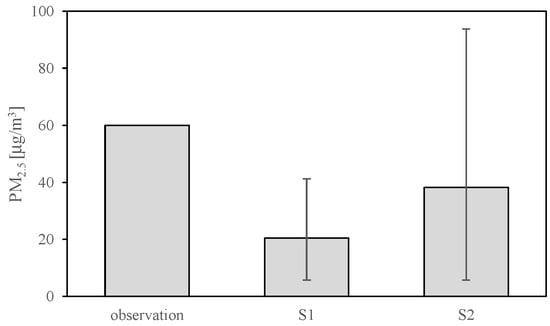
Figure 7.
Ground observation data and simulated PM2.5 concentration daily average for 19 September 2019 at Jambi. Error bars in simulation show maximum and minimum time values.
The simulation results of S1 and S2 were compared to see how much impact changing the injection height has on AOT and PM2.5. At Jambi, the S1 simulation had a 4.4 times higher AOT than the S2 simulation, but 0.54 times higher PM2.5. In the S1 simulation with a higher injection altitude of the fire origin aerosol, the aerosol is distributed to the upper layers, but the concentration in the lower layers is lower, and thus the PM2.5 concentration near the ground surface is lower. On the other hand, AOT is affected not only by aerosols distributed near the ground surface but also by aerosols distributed in the upper layers, which is why AOT values were larger in simulations with higher injection altitudes. AOT increased with increasing injection height near the source of the fire, but a different trend was observed downwind of the source. At Bukit_Kototabang, located northwest of Jambi, the AOT of S1 was 0.7 times higher than the AOT of S2. This may be due to the higher injection height, which reduced the aerosol transported by the underlying southeasterly winds.
A comparison of these observations indicates that S2 with an injection height of 1 km is better than S1 with an injection height of 3 km to reproduce the aerosol distribution caused by forest fires in Indonesia in September 2019. However, it cannot be said that these results are applicable to forest fires in other locations or at other times.
In this study, chemical transport modeling is used to investigate how the dispersion of air pollutants caused by wildfires varies with the injection altitude for a wildfire in eastern Sumatra in September 2019. Peat formations are widespread in Indonesia. The peat that forms the strata itself is highly flammable when dry, and once ignited and the fire penetrates the soil, it is extremely difficult to extinguish it completely. Although aerosols generated by fire are said to rise to high altitudes due to the heat of fire, the results suggest that the injection height should not be set too high in order to reproduce the distribution of aerosols originating from fire on the ground surface and in soil.
3.3. Validation of Simulation Results
Satellite observation data were used to validate the distribution of fire origin aerosols reproduced by the chemical transport model. Figure 8a is a color composite image of SGLI, with the three primary colors (R, G, and B) corresponding to the normal wavelength bands (674, 530, and 443 nm), and the dots on the image represent MODIS hotspots. From this, it can be seen that there is thick smoke drifting in the air that appears to originate from wildfires. The simulation with the injection altitude set to 1 km is used because of its good reproducibility based on AERONET data. Here, we show the top height of the biomass burning plume estimated from two directional data of SGLI. Figure 8b shows the height of the plume for the same wildfire area in Figure 4. The detailed algorithms were interpreted in a previous study [40]. Only the results are presented here. The height of the plume is classified by color. For example, red indicates the plumes that are higher than 2 km. Figure 8c presents the vertical profile of BC concentration (μg/m3), which is simulated from the regional chemical transport model along the latitude from 0.5°S to 2.0°S at two longitudes indicated by the arrows. The BC is distributed over an altitude of 2 km. There is no discrepancy between the simulated BC and the BBA plume top height calculated from the SGLI data. From this, it is possible to say that the numerical model has been partly validated by the BBA plume heights estimated from the SGLI data.
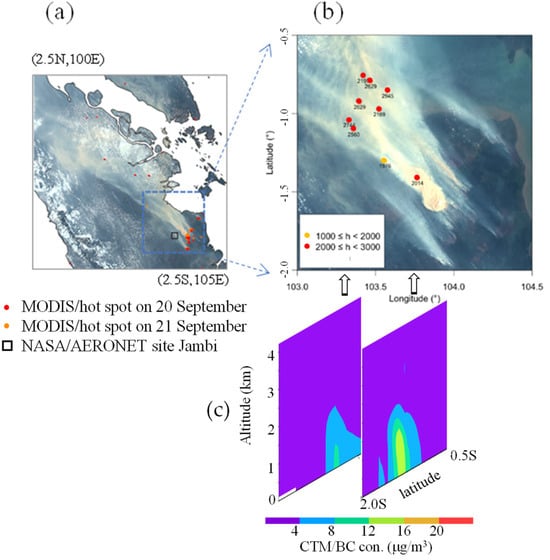
Figure 8.
(a) SGLI color composite image and (b) biomass barning aerosol plume height derived from GCOM-C/SGLI at 3:30 UT on 21 September 2019 and (c) vertical profile of BC concentration simulated by chemical transport model along latitude from 0.5°S to 2.0°S at each longitude denoted by arrow.
Figure 9 shows the BC concentration distribution by altitude based on the regional chemical transport model for S2, which is the same as in Figure 5a, but the clouds defined with JAXA/SGLI/L2/ver-2 are represented by gray. To make it easier to compare with the satellite image, areas determined to be clouds in the satellite data are grayed out. The SGLI is a multi-wavelength sensor from near-UV to thermal infrared, including red and near-IR polarization channels. The reflectance is shown in Figure 10a, and the polarized reflectance is shown in Figure 10b at wavelengths of 869 nm. The reflectance image corresponds well to the color composite image in Figure 8, with high values spread over a wide area of dark smoke. The polarized reflectance image shows particularly high values near the fire source. Figure 9 shows the distribution of BC concentrations by altitude based on the regional chemical transport model for the same time and extent as the SGLI data in Figure 10. BC concentrations are high in the lower layers, with the distribution of high concentration points toward the northwest from the hotspot, which corresponds to the location of high radiation levels in the satellite images. Furthermore, in the sky, BC concentrations in the area near the hotspot are higher than those in the surrounding area. Comparing the model results with SGLI radiance and polarized radiance, it is clear that the distribution of polarized reflectance corresponds well with the BC distribution in the upper atmosphere. It is known that polarized radiance easily reflects the characteristics of aerosols in the upper atmosphere, indicating that polarization information is useful for understanding aerosols in the upper atmosphere. Although the top height of the BBA plume can be estimated from the SGLI/2-direction data, it is difficult to obtain information at each elevation. By comparing the top height of the BBA plume with the aerosol optical properties retrieved at each SGLI pixel, we would like to report on this issue after investigating the relationship between the BBA plume top height and particle size.
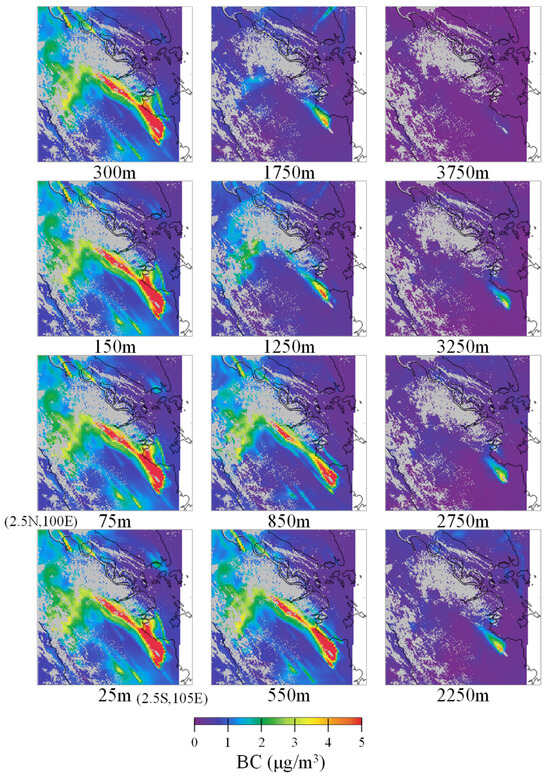
Figure 9.
BC concentration distribution by altitude simulated by the regional chemical transport model at 3:30 UT on 21 September 2019 for S2. The numbers in the lower section of the panels indicate the altitude (m). The clouds defined with JAXA/SGLI/L2/ver-2 are represented by gray.
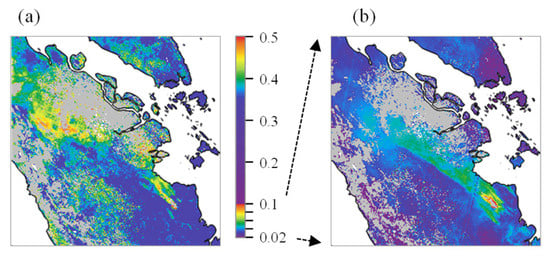
Figure 10.
(a) Reflectance and (b) polarized reflectance at 869 nm derived from GCOM-C/SGLI at 3:30 UT on 21 September 2019 over same scene as Figure 5. Clouds defined with JAXA/SGLI/L2/ver-2 are represented by gray.
Next, the model results are validated using the top heights of the biomass burning (BBA) plume estimated from SGLI polarization observations. SGLI polarization measurement uses a dedicated optical system attached to the sensor via a tilt mechanism. The tilt angle of the polarization optics was fixed at forward 45° in the northern hemisphere and backward 45° in the southern hemisphere. These tilted polarization optics enable global two-directional radiance measurements in combination with nadir multispectral radiance-only optics. With satellite data in two directions, the 3D position of the target can be estimated by triangulation methods. The detailed algorithm has been interpreted in a previous study [43], so only the results are presented here. Figure 5b shows the top height of the BBA plume from the same wildfire shown in Figure 5a. The top heights of the BBA plumes in Figure 5b are estimated from the two-directional data of SGLI. The height of the plume is classified by color. For example, the red color indicates the plumes is higher than 2 km, and then the BBA plume height from the wildfires in Sumatra is estimated to be about 2 to 3 km. This result is consistent with the vertical distribution of BC simulated by our model. A comparison of the satellite data and model simulations shows that the model simulations reproduce the distribution of biomass burning aerosols in Sumatra.
4. Discussion
Model simulations were validated by the horizontal distribution and plume heights of BBA estimated from SGLI satellite data. Furthermore, quantitative comparisons with observations must be made for accurate evaluation of model results. In comparison with AERONET data, model results at a given location are quantitatively verified with observations, but to investigate the similarity of the spatial extent, we correlated satellite data from SGLI with simulated values.
Here, we examined the correlation between the model results and the SGLI data by aligning the spatial resolution of the data to 50 km. It was determined from Figure 11a–c that the reflectance (R) from the top of the atmosphere values increased with the AOT but converged at some AOT points. The absolute value and slope of R(AOT) vary with the wavelength and particle model; however, the approximate expression of R(AOT) remains the same form as follows:
where β is an arbitrary coefficient that includes uncertain variables such as the particle emission power and optical properties, resulting in the following:
R(AOT) ≈ R (∞)(1 − e−AOT/β),
R (∞) ≡ α,
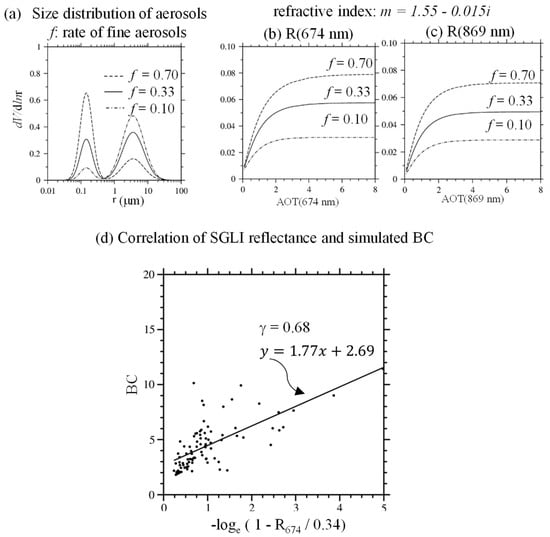
Figure 11.
Examples of reflectance versus aerosol optical thickness (AOT) for carbonaceous aerosol model. (a) Bi-modal log-normal size distribution with fine particle fraction f, (b) reflectance (R) versus aerosol optical thickness (AOT) at wavelength λ = 674 nm, (c) same as (b) but for λ = 869 nm, (d) correlation of SGLI reflectance and simulated BC in 50 km resolution at 3:30 UT on 21 September 2019.
Function R(AOT) can then be rewritten by using Equation (2). This is the expected relationship between the simulated BC and SGLI radiance data (SGLI_R (λ)) at wavelength λ.
BC/β ≈ −log(1 − SGLI_R (λ)/α),
Figure 11 shows the correlation diagram between the cumulative BC simulated by the chemical transport model and −log(1 − SGLI_R(674 nm)/0.36) at 50 km resolution, where SGLI_R(674 nm) represents the SGLI data at a wavelength of 674 nm. The correlation coefficient takes the value of γ = 0.68. So, spatial distribution correlations are not low, confirming that the model simulations are in quantitative agreement with the SGLI observations.
5. Conclusions
In this study, chemical transport modeling was used to investigate how the dispersion of air pollutants from wildfires varies with the eruption altitude of a wildfire that occurred in Sumatra in September 2019. Several reports have noted that large wildfires allow BBA plumes to reach the free troposphere. Aerosols from wildfires can be ejected at high altitudes due to lift from combustion. However, peat layers are widely distributed in Indonesia [2], and aerosols originating from surface and subsoil fires, such as peat fires, were well reproduced by simulations that did not set the injection height too high.
To validate the model results, comparisons were made at ground stations and with horizontal distributions and smoke heights obtained from satellite observation data. These comparisons confirm the validity of the model results. In addition, the SGLI data were used to quantitatively verify the reproducibility of the horizontal BC distribution of the model results. The results also showed a correlation between the two, indicating that the model simulations were generally able to represent the distribution of aerosols originating from forest fires. Chemical transport models are effective tools for reproducing the behavior of atmospheric aerosol transport. The results suggest that incorporating accurate injection height into chemical transport models can improve the accuracy of air quality predictions and contribute to more reliable climate models, especially in areas where wildfires are frequent.
Author Contributions
Software, M.N.; Validation, S.M.; Investigation, M.N.; Writing—original draft, M.N.; Writing—review & editing, S.M.; Funding acquisition, S.M. All authors have read and agreed to the published version of the manuscript.
Funding
The authors thank JAXA for distributing the GCOM-C/SGLI data. This work was supported in part by the Global Change Observation Mission Climate Project of JAXA (no. JX-PSPC-563244).
Data Availability Statement
The original contributions presented in the study are included in the article, further inquiries can be directed to the corresponding author.
Conflicts of Interest
The authors declare no conflicts of interest.
Abbreviations
The following abbreviations are used in this manuscript:
| BBAs | Biomass burning aerosols |
| SCALE | Scalable Computing for Advanced Library and the Environmental Regional Model |
| GCOM-C | Global Change Observation Mission-Climate |
| SGLI | Second-Generation global Imager |
| NASA | The National Aeronautics and Space Administration |
| AERONET | AErosol RObotic NETwork |
| IR | InfraRed |
| AOT | Aerosol optical thickness |
References
- Global Peatland Initiative, World Peatland Map. 2002. Available online: https://globalpeatlands.org/resource-library/global-peatland-map-20 (accessed on 4 March 2025).
- Hooijer, A.; Silvius, M.; Wösten, H.; Page, S. PEAT-CO2, Assessment of CO2 Emissions from Drained Peatlands in SE Asia; Delft Hydraulics Report Q3943, in Cooperation with Wetlands International and Alterra; Delft Hydraulics: Delft, The Netherlands, 2006. [Google Scholar]
- Wetlands International. Maps of Peatland Distribution and Carbon Content in Sumatera, 1990–2002. 2003. Available online: https://www.yumpu.com/id/document/read/23366016/atlas-sebaran-gambut-sumatera (accessed on 4 March 2025).
- Wetlands International, Maps of Peatland Distribution and Carbon Content in Kalimantan, 2000–2002. 2004. Available online: https://www.academia.edu/24344060/Atlas_Sebaran_Gambut_Kalimantan (accessed on 4 March 2025).
- Hooijer, A.; Page, S.; Canadell, J.G.; Silvius, M.; Kwadijk, J.; Wosten, H.; Jauhiainen, J. Current and future CO2 emissions from drained peatlands in Southeast Asia. Biogeosci. Discuss. 2009, 6, 7207–7230. Available online: https://www.biogeosciences-discuss.net/6/7207/2009/ (accessed on 4 March 2025). [CrossRef]
- Susetyo, K.E.; Kusin, K.; Nina, Y.; Jagau, Y.; Kawasaki, M.; Naito, D. 2019 Peatland and Forest Fires in Central Kalimantan, Indonesia. Newsl. Trop. Peatl. Soc. Proj. 2020, 8, 1–4. [Google Scholar]
- Osawa, T.; Kajita, R. News of Indonesian Fires in 2019. Newsl. Trop. Peatl. Soc. Proj. 2020, 8, 8–10. [Google Scholar]
- Freitas, S.R.; Longo, K.M.; Andreae, M.O. Impact of including the plume rise of vegetation fires in numerical simulations of associated atmospheric pollutants. Geophys. Res. Lett. 2006, 33, L17808. [Google Scholar] [CrossRef]
- Fromm, M.; Bevilacqua, R.; Servranckx, R.; Rosen, J.; Thayer, J.P.; Herman, J.; Larko, D. Pyro-cumulonimbus injection of smoke to the stratosphere: Observations and impact of a super blowup in northwestern Canada on 3–4 August 1998. J. Geophys. Res.-Atmos. 2005, 110, D08205. [Google Scholar] [CrossRef]
- Kahn, R.A.; Chen, Y.; Nelson, D.L.; Leung, F.-Y.; Li, Q.; Diner, D.J.; Logan, J.A. Wildfire smoke injection heights: Two perspectives from space. Geophys. Res. Lett. 2008, 35, L04809. [Google Scholar] [CrossRef]
- Amiridis, V.; Giannakaki, E.; Balis, D.S.; Gerasopoulos, E.; Pytharoulis, I.; Zanis, P.; Kazadzis, S.; Melas, D.; Zerefos, C. Smoke injection heights from agricultural burning in Eastern Europe as seen by CALIPSO. Atmos. Chem. Phys. 2010, 10, 11567–11576. [Google Scholar] [CrossRef]
- Wooster, M.J.; Perry, G.L.W.; Zoumas, A. Fire, drought and El Niño relationships on Borneo (Southeast Asia) in the pre-MODIS era (1980–2000). Biogeosciences 2012, 9, 317–340. [Google Scholar] [CrossRef]
- Leung, F.-Y.T.; Logan, J.A.; Park, R.; Hyer, E.; Kasischke, E.; Streets, D.; Yurganov, L. Impacts of enhanced biomass burning in the boreal forests in 1998 on tropospheric chemistry and the sensitivity of model results to the injection height of emissions. J. Geophys. Res. 2007, 112, D10313. [Google Scholar] [CrossRef]
- Zhu, L.; Val Martin, M.; Gatti, L.V.; Kahn, R.; Hecobian, A.; Fischer, E.V. Development and implementation of a new biomass burning emissions injection height scheme (BBEIH v1.0) for the GEOS-Chem model (v9-01-01). Geosci. Model Dev. 2018, 11, 4103–4116. [Google Scholar] [CrossRef]
- Reid, J.; Hyer, E.; Prins, E.; Westphal, D.; Zhang, J.; Wang, J.; Christopher, S.; Curtis, C.; Schmidt, C.; Eleuterio, D.; et al. Global Monitoring and Forecasting of Biomass-Burning Smoke: Description of and Lessons From the Fire Locating and Modeling of Burning Emissions (FLAMBE) Program. Sel. Top. Appl. Earth Obs. Remote Sens. 2009, 2, 144–162. [Google Scholar] [CrossRef]
- van der Werf, G.R.; Randerson, J.T.; Giglio, L.; Collatz, G.J.; Mu, M.; Kasibhatla, P.S.; Morton, D.C.; DeFries, R.S.; Jin, Y.; van Leeuwen, T.T. Global fire emissions and the contribution of deforestation, savanna, forest, agricultural, and peat fires (1997 2009). Atmos. Chem. Phys. 2010, 10, 11707–11735. [Google Scholar] [CrossRef]
- Wiedinmyer, C.; Akagi, S.K.; Yokelson, R.J.; Emmons, L.K.; Al Saadi, J.A.; Orlando, J.J.; Soja, A.J. The Fire INventory from NCAR (FINN): A high resolution global model to estimate the emissions from open burning. Geosci. Model Dev. 2011, 4, 625–641. [Google Scholar] [CrossRef]
- Kaiser, J.W.; Heil, A.; Andreae, M.O.; Benedetti, A.; Chubarova, N.; Jones, L.; Morcrette, J.-J.; Razinger, M.; Schultz, M.G.; Suttie, M.; et al. Biomass burning emissions estimated with a global fire assimilation system based on observed fire radiative power. Biogeosciences 2012, 9, 527–554. [Google Scholar] [CrossRef]
- Trentmann, J.; Luderer, G.; Winterrath, T.; Fromm, M.D.; Servranckx, R.; Textor, C.; Herzog, M.; Graf, H.-F.; Andreae, M.O. Modeling of biomass smoke injection into the lower stratosphere by a large forest fire (Part I): Reference simulation. Atmos. Chem. Phys. 2006, 6, 5247–5260. [Google Scholar] [CrossRef]
- Hyer, E.J.; Chew, B.N. Aerosol transport model evaluation of an extreme smoke episode in Southeast Asia. Atmos. Environ. 2010, 44, 1422–1427. [Google Scholar] [CrossRef]
- Freitas, S.R.; Longo, K.M.; Chatfield, R.; Latham, D.; Silva Dias, M.A.F.; Andreae, M.O.; Prins, E.; Santos, J.C.; Gielow, R.; Carvalho, J.A., Jr. Including the sub-grid scale plume rise of vegetation fires in low resolution atmospheric transport models. Atmos. Chem. Phys. 2007, 7, 3385–3398. [Google Scholar] [CrossRef]
- Rio, C.; Hourdin, F.; Chédin, A. Numerical simulation of tropospheric injection of biomass burning products by pyro-thermal plumes. Atmos. Chem. Phys. 2010, 10, 3463–3478. [Google Scholar] [CrossRef]
- Sofiev, M.; Ermakova, T.; Vankevich, R. Evaluation of the smoke-injection height from wild-land fires using remote-sensing data. Atmos. Chem. Phys. 2012, 12, 1995–2006. [Google Scholar] [CrossRef]
- Freitas, S.R.; Longo, K.M.; Silva Dias, M.A.F.; Chatfield, R.; Silva Dias, P.; Artaxo, P.; Andreae, M.O.; Grell, G.; Rodrigues, L.F.; Fazenda, A.; et al. The Coupled Aerosol and Tracer Transport model to the Brazilian developments on the Regional Atmospheric Modeling System (CATT-BRAMS)–Part 1: Model description and evaluation. Atmos. Chem. Phys. 2009, 9, 2843–2861. [Google Scholar] [CrossRef]
- Longo, K.M.; Freitas, S.R.; Andreae, M.O.; Setzer, A.; Prins, E.; Artaxo, P. The Coupled Aerosol and Tracer Transport model to the Brazilian developments on the Regional Atmospheric Modeling System (CATT-BRAMS)–Part 2: Model sensitivity to the biomass burning inventories. Atmos. Chem. Phys. 2010, 10, 5785–5795. [Google Scholar] [CrossRef]
- Paugam, R.; Wooster, M.; Freitas, S.; Val Martin, M. A re view of approaches to estimate wildfire plume injection height within large-scale atmospheric chemical transport models. Atmos. Chem. Phys. 2016, 16, 907–925. [Google Scholar] [CrossRef]
- Val Martin, M.; Kahn, R.A.; Logan, J.A.; Paugam, R.; Wooster, M.; Ichoku, C. Space-based observational constraints for 1 D fire smoke plume-rise models. J. Geophys. Res.-Atmos. 2012, 117, D22204. [Google Scholar] [CrossRef]
- Kajino, M.; Deushi, M.; Sekiyama, T.T.; Oshima, N.; Yumimoto, K.; Tanaka, T.Y.; Ching, J.; Hashimoto, A.; Yamamoto, T.; Ikegami, M.; et al. Comparison of three aerosol representations of NHM-Chem (v1.0) for the simulations of air quality and climate-relevant variables. Geosci. Model Dev. 2021, 14, 2235–2264. [Google Scholar] [CrossRef]
- Nakata, M.; Kajino, M.; Sato, Y. Effects of mountains on aerosols determined by AERONET/DRAGON/JALPS measurements and regional model simulations. Earth Space Sci. 2021, 8, e2021EA001972. [Google Scholar] [CrossRef]
- Nishizawa, S.; Yashiro, H.; Sato, Y.; Miyamoto, Y.; Tomita, H. Influence of grid aspect ratio on planetary boundary layer turbulence in large-eddy simulations. Geosci. Model Dev. 2015, 8, 3393–3419. [Google Scholar] [CrossRef]
- Sato, Y.; Nishizawa, S.; Yashiro, H.; Miyamoto, Y.; Kajikawa, Y.; Tomita, H. Impacts of cloud microphysics on trade wind cumulus: Which cloud microphysics processes contribute to the diversity in a large eddy simulation? Prog. Earth Planet. Sci. 2015, 2, 23. [Google Scholar] [CrossRef]
- Labonne, L.; Bre’on, F.-M.; Chevallier, F. Injection height of biomass burning aerosols as seen from a spaceborne lidar. Geophys. Res. Lett. 2007, 34, L11806. [Google Scholar] [CrossRef]
- Fromm, M.D.; Alfred, J.; Hoppel, K.; Hornstein, J.; Bevilacqua, R.; Shet-tle, E.; Servranckx, R.; Li, Z.; Stocks, B. Observations of boreal forest fire smoke in the stratosphere by POAM III, SAGE II, and lidar in 1998. Geophys. Res. Lett. 2000, 27, 1407–1410. [Google Scholar] [CrossRef]
- Takemura, T.; Okamoto, H.; Maruyama, Y.; Numaguti, A.; Higurashi, A.; Nakajima, T. Global three-dimensional simulation of aerosol optical thickness distribution of various origins. J. Geophys. Res. 2000, 105, 17853–17873. [Google Scholar] [CrossRef]
- Kaufman, Y.J.; Setzer, A.; Ward, D.; Tanre, D.; Holben, B.N.; Menzel, P.; Pereira, M.C.; Rasmussen, R. Biomass burning airborne and space borne experiment in the Amazonas (BASE-A). J. Geophys. Res. 1992, 97, 14581–14599. [Google Scholar] [CrossRef]
- Browell, E.V.; Fenn, M.A.; Butler, C.F.; Grant, W.B.; Clayton, M.B.; Fishman, J.; Bachmeier, A.S.; Anderson, B.E.; Gregory, G.L.; Fuelberg, H.E.; et al. Ozone and aerosol distributions and air mass characteristics over the South Atlantic Basin during the burning season. J. Geophys. Res. 1996, 101, 24043–24068. [Google Scholar] [CrossRef]
- Liu, X.; Penner, J.E.; Herzog, M. Global modeling of aerosol dynamics: Model description, evaluation, and interactions between sulfate and nonsulfate aerosols. J. Geophys. Res. 2005, 110, D18206. [Google Scholar] [CrossRef]
- Holben, B.N.; Eck, T.F.; Slutsker, I.; Tanré, D.; Buis, J.P.; Setzer, A.; Vermote, E.; Reagan, J.A.; Kaufman, Y.J.; Nakajima, T.; et al. AERONET—A federated instrumentnetwork and data archive for aerosol characterization. Remote Sens. Environ. 1998, 66, 1–16. [Google Scholar] [CrossRef]
- Giles, D.M.; Sinyuk, A.; Sorokin, M.G.; Schafer, J.S.; Smirnov, A.; Slutsker, I.; Eck, T.F.; Holben, B.N.; Lewis, J.R.; Campbell, J.R.; et al. Advancements in the Aerosol Robotic Network (AERONET) Version 3 database—Automated near-real-time quality control algorithm with improved cloud screening for Sun photometer aerosol optical depth (AOD) measurements. Atmos. Meas. Technol. 2019, 12, 169–209. [Google Scholar] [CrossRef]
- Mukai, S.; Hioki, S.; Nakata, M. Biomass Burning Plume from Simultaneous Observations of Polarization and Radiance at Different Viewing Directions with SGLI. Remote Sens. 2023, 15, 5405. [Google Scholar] [CrossRef]
- Nakata, M.; Sano, I.; Mukai, S.; Kokhanovsky, A. Characterization of wildfire smoke over complex terrain using satellite observations, ground-based observations, and meteorological models. Remote Sens. 2022, 14, 2344. [Google Scholar] [CrossRef]
- Nakata, M.; Mukai, S.; Fujito, T. Direct Detection of Severe Biomass Burning Aerosols from Satellite. Atmosphere 2022, 13, 913. [Google Scholar] [CrossRef]
- Hioki, S.; Funatomi, T.; Nakata, M.; Mukai, S.; Kidode, M. Stereoscopic height estimation of biomass burning aerosol and volcanic ash plumes by the second-generation global imager (SGLI). Proc. SPIE 2024, 13193, 131930B. [Google Scholar] [CrossRef]
Disclaimer/Publisher’s Note: The statements, opinions and data contained in all publications are solely those of the individual author(s) and contributor(s) and not of MDPI and/or the editor(s). MDPI and/or the editor(s) disclaim responsibility for any injury to people or property resulting from any ideas, methods, instructions or products referred to in the content. |
© 2025 by the authors. Licensee MDPI, Basel, Switzerland. This article is an open access article distributed under the terms and conditions of the Creative Commons Attribution (CC BY) license (https://creativecommons.org/licenses/by/4.0/).